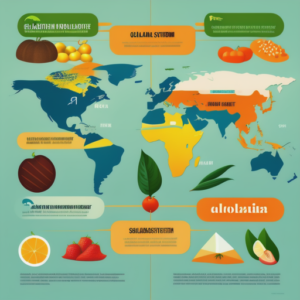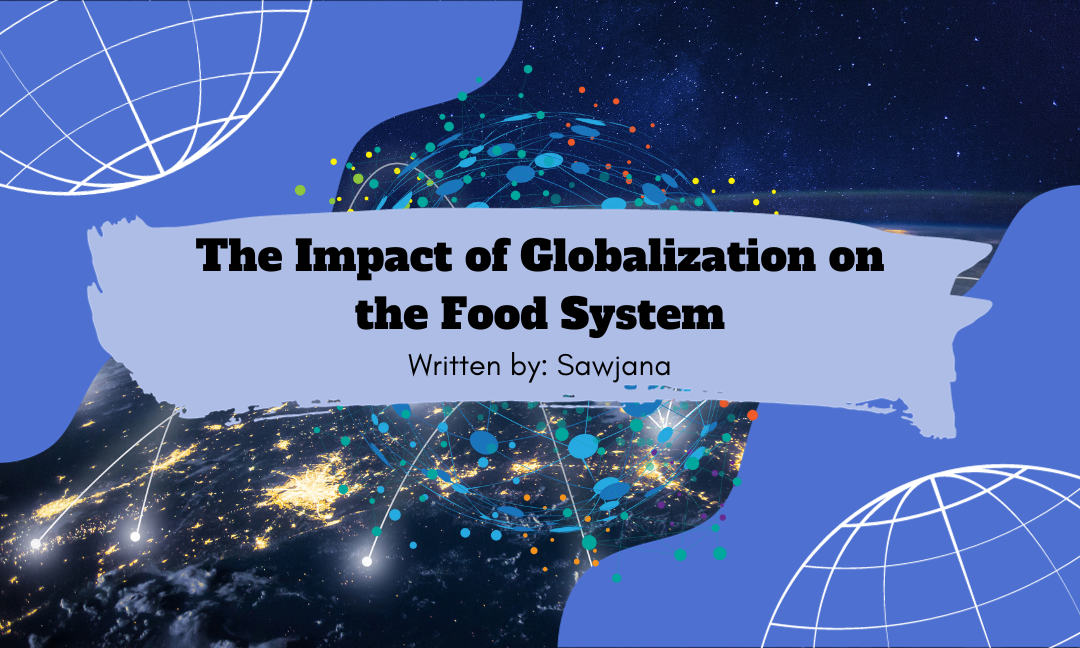Written by Sawjana
Edited by Koneenika Datta
Designed by Ayesha
Published by Kiritika Rana
 Globalization has brought about profound changes in various sectors, including the food system, in an increasingly interconnected world. As nations and economies become more interdependent, food production, distribution, and consumption have undergone significant transformations. This article aims to explore the multifaceted impact of globalization on the food system, shedding light on both the positive and negative consequences that have emerged.
Globalization has brought about profound changes in various sectors, including the food system, in an increasingly interconnected world. As nations and economies become more interdependent, food production, distribution, and consumption have undergone significant transformations. This article aims to explore the multifaceted impact of globalization on the food system, shedding light on both the positive and negative consequences that have emerged.
- Expansion of Trade and Food Availability:
Globalization has facilitated the movement of goods across borders, enabling a diverse array of foods to be accessible to consumers worldwide. The expansion of international trade has led to the year-round availability of seasonal and non-native foods. This has created opportunities for consumers to experience a broader range of culinary options, promoting cultural exchange and gastronomic diversity.
- Altered Food Production Practices:
The globalization of the food system has triggered changes in food production practices. To meet the demands of global markets, many producers have shifted towards mono-cropping and large-scale farming. While this has improved efficiency and reduced costs, it has also led to concerns about biodiversity loss, soil degradation, and the potential overreliance on a few staple crops.
- Impact on Local Agriculture:
Small-scale farmers in developing countries have been both positively and negatively affected by globalization. On one hand, access to international markets can provide new income opportunities and technological advancements. On the other hand, increased competition from imported goods can threaten the livelihoods of local farmers, leading to a dependency on imported foods rather than self-sustenance.
- Food Security and Vulnerability
Globalization has introduced both benefits and challenges to food security. While international trade can provide food during local scarcity, it can also leave communities vulnerable to fluctuations in global food prices and supply chain disruptions. Additionally, the focus on exporting cash crops for profit may divert resources away from growing staple foods, potentially exacerbating food insecurity in certain regions.
- Cultural Homogenization vs. Preservation:
As Western dietary patterns and fast food chains spread globally, concerns arise regarding the potential loss of traditional dietary practices and cultural heritage. Globalization’s influence on the food system can lead to the adoption of standardized diets and the erosion of culinary diversity. However, it is worth noting that the exchange of culinary traditions across borders can also enrich local cuisines.
- Environmental Impact:
The long-distance transportation of food has contributed to increased carbon emissions and environmental degradation. The “food miles” associated with transporting goods across continents can negatively affect climate change and resource consumption. Efforts to promote local and sustainable food production have gained traction as a response to these concerns.
The impact of globalization on the food system is a complex and multifaceted phenomenon. While it has undoubtedly expanded food choices and facilitated international trade, it has also raised questions about food security, cultural preservation, and environmental sustainability. As we continue to navigate the challenges and opportunities presented by globalization, it is crucial to adopt holistic approaches that prioritize the well-being of both people and the planet. Whether through supporting local farmers, embracing sustainable agricultural practices, or fostering cultural exchange, we can shape a food system that is equitable, resilient, and diverse in the face of ongoing globalization.
Reference List
McMichael, P. (2009). A food regime analysis of the ‘world food crisis’. Agriculture and Human Values, 26(4), 281-295.
Lang, T., & Heasman, M. (2004). Food Wars: The Global Battle for Mouths, Minds, and Markets. Earthscan.
Popkin, B. M. (2006). Global nutrition dynamics: The world is shifting rapidly toward a diet linked with noncommunicable diseases. The American Journal of Clinical Nutrition, 84(2), 289-298.
Reardon, T., & Timmer, P. (2012). Transformation of markets for agricultural output in developing countries since 1950: How has thinking changed? In M. R. Carter & C. B. Barrett
(Eds.), The economics of poverty traps (pp. 1-41). University of California Press.
McMichael, P. (2012). The land grab and corporate food regime restructuring. The Journal of Peasant Studies, 39 (3-4), 681-701.

